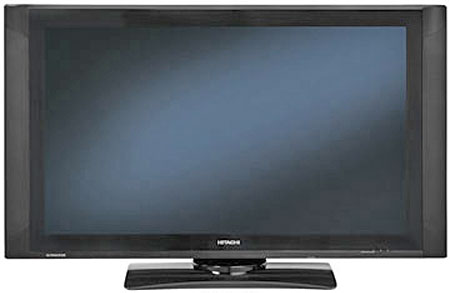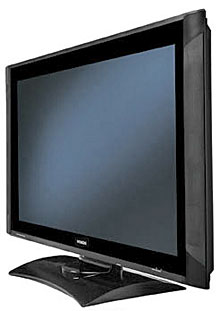Hitachi 42HDT52 Plasma Television

Oh how times have changed, as Hitachi's 42HDT52 makes clear. Like many of today's plasmas this 42" (diagonal) model comes loaded with features, providing an analog tuner, a digital tuner with CableCARD connectivity, 2-way, side-mounted speakers and amplification totaling a rated 40-watts. And the list price is just $3,399. That's still quite a lot for a television, of course, but a fraction of what a comparable product and all the assorted outboard equipment would have cost just three or four years ago.
It's a handsome unit, all black, on a table-top base that swivels. In fact, the swivel is electric; you can control it from the remote – an intriguing feature. To my eye, though, the base seems bulky, given the svelte nature of the product it supports. Some manufacturers try to hide the stand, but those designs would not have allowed the ultra-convenient swivel feature Hitachi provides.
Hitachi has a long history with plasmas. It shares a production plant with Fujitsu, and Hitachi recently bought a majority share in that Japanese property. Hitachi has announced it will build a new production line at the plant and ramp up production to 200,000 units a month by next fall.
Hitachi apparently believes that plasma holds the most promise among the competing new flat panel TV technologies. Plasmas have gotten much cheaper per square inch than any of us might have believed possible, and of course they have that thin form factor. This one is only 4.25 inches deep – actually a bit fat for a plasma- but still thin enough to be hung on the wall and credibly blend in.
Hitachi of course makes larger and more expensive displays in this line. But it is among the 42-inch plasma models that prices have dropped most dramatically, making them approachable for a larger group of consumers. That is why I wanted to look at this one. Plasmas of this size have been in production longer, meaning the screens are less expensive to make.
This one offers 1024x1024 resolution. The company still advertises this as a 1080-line HDTV, 1920x1080 being one of the two standard resolutions for high-definition. With 1080i HD material the company explains that a portion of the 1080 vertical pixels are simply eliminated, with no scaling in the vertical plane, which eliminates artifacts typically involved in the process when a 1920x1080 signal is downconverted to something like the 768 horizontal pixel rows common to many plasma displays. I have no reason to quarrel with that explanation. I just wonder why other manufacturers aren't making the same argument, though many companies do offer sets with 1024 vertical lines. All other incoming signals are scaled to 1024x1024.
The 42HDT52 has a split screen function, and two HDMI inputs as well as a USB jack for computers. And given the multiplicity of features, the plasma comes with a major remote replete with useful features, including very nice scroll wheels for volume and channel selection. And it is fully backlit.
The set offers six different aspect-ratio settings, selectable from the remote, for watching 4:3 material on the 16:9 screen. It comes with a subscription to TV Guide's on-screen Electronic Program Guide (EPG). It's a standard looking guide, with an advertisement that occupies the lower right corner of the screen. If you find on-screen guides convenient, you'll appreciate this one. The set also supports a CableCARD for direct SD and HD cable reception without a set-top box, though I did not test this feature.
Among the other features is a freeze-frame function and dual screen picture-in-picture. Input selection is accomplished by pressing a button that calls up a list of inputs on-screen. You then scroll to the one you want. This is preferable, in my view, to pressing the input button endlessly until you get to the input you want – an endless process these days with TVs that have seven or eight inputs. But the ideal approach is to have direct-access buttons on the remote, something few manufacturers offer.
The 42HDT52 offers separate picture setting memories for every input, allowing you to adjust for each device you have plugged into the set. The on-screen menus were slick-looking and worked well. Once you choose the parameter you want to adjust, the adjustment bar falls to the bottom of the screen where it remains visible but out of the way while you make your changes.
 Setup
Setup
Connecting the 42HDT52 to my system was simple enough. With built-in tuners, I had only to connect an RF feed from my rooftop antenna and component cables from my DVD player.
Like almost every manufacturer, Hitachi sends its sets out set in "dynamic" mode with the contrast cranked all the way to 100 percent. Immediately after I switched it on and before doing anything else, I changed the color temperature setting to "normal" and turned the contrast down to about 50 percent. Much better.
I ran the set though a series of tests, first the test patterns on Video Essentials and then the Silicon Optix HQV Benchmark test disc. The Hitachi fared reasonably well.
Resolution was outstanding, and stability was unquestioned. Many plasmas I've seen are flaky on screen uniformity; on a solid gray screen, half the screen will be lighter than the other, or it will exhibit noise or jitter. The Hitachi was rock solid, and the picture relatively clean – though I did see a bit of video noise in some dark areas of an active picture. Dot patterns, white dots on a black screen, often are the bane of plasmas. The dots are not round, and the phosphors misalign so that the dots have a red or green tinge. On the Hitachi, the dots were rendered perfectly, something I do not remember seeing on a plasma before.
Color rendition was good, but red push – a failing of many TVs – was extreme. Reds were far more pronounced than they should be. And to adjust for that, the color control had to be dialed way down, affecting the balance of all the other colors.
Deinterlacing and scaling is a significant problem for many modern sets. The circuitry used to convert a 480-line standard definition signal up to the set's native resolution can introduce extremely bothersome artifacts. Hitachi has had problems with this in the past. But I am glad to report that the scaler on this set is fairly good. The Silicon Optix disc offers several torture tests for scalers and video processors. And while the Hitachi did not perform at the very top of the scale on any of the tests, it was close in most cases—reliably good. I could see a jagged line or related video artifacts a time or two as I watched the set, but it was not a serious problem that regularly interfered and detracted from the pleasure of watching.
All good news so far. But here is the set's Achilles heel: black levels. Among the many circuitry-feature buzz-phrases that Hitachi (like every manufacturer) throws on its specification list is "4-step black enhancement." Well, maybe the company should have dialed it up to 8-step, or even nine.
As most everyone knows by now, plasmas typically have trouble rendering subtle shades of deep black and holding black levels steady when brighter material is on screen at the same time (also known as black level retention). The industry as a whole has improved its performance on this by great strides over the last five years. After Jamie Wilson of Overture Audio/Video performed his ISF calibration of the set, the black-level performance was respectable, but blacks remained, at best, dark gray rather than deep, rich black.
I watched Hotel Rwanda and, overall, enjoyed the Hitachi immensely. The movie offers a riot of colors. (Unfortunately too much of it was blood red – a feature of the movie, not the set.) But the Hitachi was a champ – bright, colorful and free of the annoying quirks and glitches that plague so many plasmas. The only irritant was the limited black level and shadow detail. The movie was set in Africa, of course, and so most every character had black hair. On the Hitachi, the hair lacked distinct features and texture, looking as if it was painted on.
I used the built-in over-the-air digital tuner to watch HDTV. First, I let the tuner search for stations, and it found all eight of the over-the-air channels in Washington D.C. But it was able to display only six of the channels. The other two were broken up and therefore unwatchable, even after I adjusted my rooftop antenna. I tried several times, at different times of the day, and got the same result.
A top-of the-line digital tuner should be able to resolve all eight channels. Your experience with this tuner may be different. It may perform better – or worse, depending on your location, terrain, distance from the towers, etc. But I have been reviewing digital tuners since 1998, under the exact same conditions. And this one does not perform as well as some others I have seen recently, or as my reference tuners do.
High-definition was quite nice – sharp, bright. Color rendition was excellent; the set showed the wider palate of color that high-definition offers. On over-the-air 1080i HD material the Hitachi's performance was pleasing, no question. But it was nowhere near the point at which I felt I was looking out a window rather than watching TV, particularly in those darker scenes. One sequence in an episode of Cold Case on CBS (a show I had never watched before), took place in an office building at night. Two women were talking in a barely lit office, and it was hard to tell what surrounded them because the Hitachi was unable to render much in the way of shadow detail.
Conclusion
There's a lot to admire on this plasma. The feature set is complete, the price is good. The black level is not among the best I have seen, which is the only thing that keeps me from offering a high recommendation.
Highs:
Stable, detailed, richly colored picture
Full feature set
Excellent remote
Lows:
Mediocre black level
Inordinately high red push
- Log in or register to post comments




















































